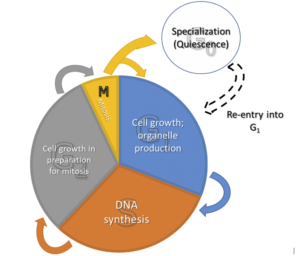To prepare for and maintain their diverse functions in the body, cells undergo the cell cycle, a highly regulated process of growth and division. It has multiple phases with their own ways of regulation to prevent mutations and damage to the cell and its components.
Interphase: Preparation for mitosis
As illustrated in Figure 1, the cell cycle has these main phases: G1, S, G2, and M. Collectively, the first three are called the interphase, while M is mitosis or cell division. This is when the cell grows, undergoes a range of metabolic processes, and makes copies of cellular components in anticipation of cell division. Cells that no longer divide and are committed to a certain function enter G0 (quiescence). The phases of the cell cycle are discussed in the following sections.
G1: cell growth, duplication of organelles
This first phase of the cell cycle is the period of time wherein cells make more copies of organelles and other cellular components. At a certain point, cells in this stage may either move on to the S (DNA synthesis) phase or, as in neurons and red blood cells, move into the G0 phase to commit to a specific function.
S: DNA synthesis
While in G1 multiple copies of the organelles are produced, the S phase is when the cell replicates DNA so that daughter cells arising from mitosis will have exact copies of the DNA. Other major steps in this phase are the duplication of centrosomes (which organize the microtubules for mitotic division) and the synthesis of histones which are proteins where DNA is wound around to fit a cell. The resulting DNA-histone complex is called chromatin.
G2: further cell growth pre-mitosis
Radioactive labeling studies by Baserga and Wiebel (1969) revealed that there is a period of time between the end of DNA synthesis and the start of cell division. This is G2, where cell volume has doubled due to intensive metabolism and growth. Cells at this stage are ready for mitosis.
Mitosis
After engaging in metabolic processes, growth, and DNA replication, the cell is now ready for mitosis. This is the process of division in somatic cells (body cells, as opposed to gametes) which produces two daughter cells with the same components. Mitosis has four main stages: prophase, metaphase, anaphase, and telophase.
- In prophase, the centrosomes separate into two centrioles which will start moving towards opposite poles of the cell. Meanwhile, the nuclear envelope disintegrates and the chromatin condenses into compact chromosomes.
- Metaphase is the stage when the centrioles have reached the poles, chromosomes have migrated at the center region of the cell (metaphase plate) and spindle fibers attach to a protein called the kinetochore at the centromere region of chromosomes.
- During anaphase, a series of processes happens to the chromosomes which causes them to disjoin and be pulled apart by the attached spindle fibers toward the poles.
- Finally, telophase is the stage at which cells separate and reform as individual daughter cells: cytokinesis divides the cytoplasm between them, chromosomes uncoil into chromatin, and the nuclear envelope reforms to enclose the genetic material.
Regulation of the Cell Cycle
Considering the complexity of the cell cycle, it is imperative that there are ways to check for errors, lest these give rise to unwanted mutations that may have deleterious effects. To prevent these errors, the cell cycle has checkpoints and regulators between phases and during mitosis.
- The G1/S checkpoint ensures that the cell has grown enough and has no damaged DNA. The latter is particularly important as replicating damaged DNA may lead to mutations that will negatively affect the organism. In response to DNA damage, the tumor suppressor protein p53 arrests the cell’s progression through the cycle at G1 and either promotes DNA repair or cell apoptosis, where the cell is killed off by the body’s own immune cells to prevent it from dividing.
- In the G2/M checkpoint, the cell is checked for replication errors and DNA damage. Proteins such as cyclin-dependent kinases cause the arrest of cells at G2 when there is DNA damage, preventing the cells from undergoing mitosis.
- A checkpoint during mitosis, the spindle checkpoint, ensures the correct attachment of spindle fibers to chromosomes between metaphase and anaphase. This checkpoint has the purpose of ensuring the correct division of genetic material between daughter cells.
Mutations and cancer
Some defective cells and genetic material may still fall through the cracks of the complex regulatory molecules and checkpoints of the cell cycle. These give rise to mutations, some of which cause cancer.
In the G1/S checkpoint, p53 is called a tumor suppressor protein. This is because when there is DNA damage, p53 accumulates to generate a signal to either repair the DNA or kill the cell. However, mutations in the gene encoding for p53 itself have been recorded in multiple types of cancer at varying degrees. These mutations disable the cell’s ability to encode p53 in its correct form and as such will be unusable in its original function. In this case, the “suppressor” was “suppressed”, enabling the expression of genes that cause cancer (oncogenes).
References:
- Baserga, R., Wiebel, F. (1969). The cell cycle of mammalian cells. Int Rev Exp Pathol., 7, 1-30.
- Iwasa, J., Marshall, W. (2018). Karp’s Cell Biology. Hoboken, NJ: John Wiley & Sons.
- Klug, W.S., Cummings, M.R., Spencer, C.A., Palladino, M.A., Killian, D.J. (2020). Essentials of Genetics (10th). Hoboken, NJ: John Wiley & Sons.
Important Quotes:
- Interphase takes about 20 hours to complete, whereas the mitotic phase takes about two hours to complete. So overall, interphase is about 10 times longer than the mitotic phase. If you do the math, overall, the cell cycle takes approximately 24 hours, although I was reading that this is very cell-dependent. So, if you’re a cell in the liver, you might take more time than that or less time than that.
- The Gap 1 phase is actually called the Gap 1 phase, because microscopically speaking, you can’t really tell that there’s anything actually going on. It looks as if the cell is just resting, hanging out in this part of the cell cycle. That’s just to say that if you were to take a microscope and actually yourself, watch it, you wouldn’t be able to tell what’s going on. You’d say, “Okay, this cell is not doing anything.” However, the cell is actually doing a lot of stuff during this time. In fact, what’s going on is the cell’s increasing its supply of proteins and DNA precursor molecules, things like nucleotides.
- G zero is just this phase that cells will sometimes take when they want to stop dividing. Importantly, this is a reversible phase. So cells can go back into the cell cycle if they want to, they can go out and go back in, or they can stay there permanently, like in the case of a neuron. I’m assuming that this is part of the reason why, if you have a brain injury you don’t grow back that part of the brain, because those cells can’t divide.
- The cell needs to replicate its DNA in this step (S phase) before it can undergo mitosis and actually split apart. If it doesn’t do that, then you’re not going to have two exact copies of genes that can be siphoned off to two different cells. You’ll have one cell split off and have all the genes, another cell split off and have no genes if you don’t replicate that DNA.
- You always hear those stories of, if you unwound the DNA of one cell, you’d be able to reach the moon or something like that, or basketball court, some length, pretty long. I’m going to fact check myself real fast here, it’s actually two meters long. If you were to take a single cell and stretch out the DNA completely, when it’s unwound, it would be two meters, which is still a lot, not quite to the moon, but that’s still pretty big distance.
- The Gap 2 phase… you can think of this as the growth phase or the growth phase two, whatever way you want to think about it because again, the cell is undergoing a period of growth. What happens during this time is the cell’s growing. There’s a really high level of protein production, and the cell starts to get ready to undergo mitosis.
- Mitosis is somatic cell division. Essentially this is the division of your somatic cells, which are the cells that are not your gametes or not your cells that can go on to produce babies.
- Once the cell has adequately grown, it’s grown to a good size and has the proteins and adequate precursors/growth factors that it needs in order to replicate its DNA, and it’s checked for DNA damage – that’s the big key here – then it could advance forward into the S phase. You don’t want to replicate that damage to DNA that could eventually lead to a tumor or cancer or something like that.
- In terms of internal regulators of the cell cycle, there’s a few that are important. I talk about p53 which is a transcription factor. There’s other transcription factors that control the cell cycle, but p53 is a negative regulator because as I said, it tends to halt the G1 phase and not let it move on to the S phase.
- What happens if you have a mutation in this TP53 gene that results in loss of function of p53? Well, you no longer are as effective at inducing cell-cycle arrest at the G1/S checkpoint and so then the cell cycle will move into the S phase from G1 without making sure that all of its DNA is okay.
Please email me if you have any comments or concerns: MCATpodcast@medschoolcoach.com
Thanks for listening!



